
APIs as Products: A CTO’s Roadmap to Thriving in the API Economy
October 15, 2025 / Bryan ReynoldsThe API Economy: A CTO's Guide to Designing, Building, and Monetizing APIs as Strategic Products
Introduction: Beyond Integration—APIs as the Engine of Modern Value Creation
In the landscape of digital transformation, few concepts have transitioned from technical implementation detail to boardroom-level strategic imperative as rapidly as the Application Programming Interface (API). Once relegated to the domain of software integration, APIs are now the fundamental building blocks of the modern digital economy, serving as the conduits for data, services, and value exchange between businesses, partners, and customers. This shift has given rise to the API economy—a global ecosystem built on the controlled, commercial exchange of digital assets through APIs, enabling organizations to evolve from standalone businesses into interconnected platforms.
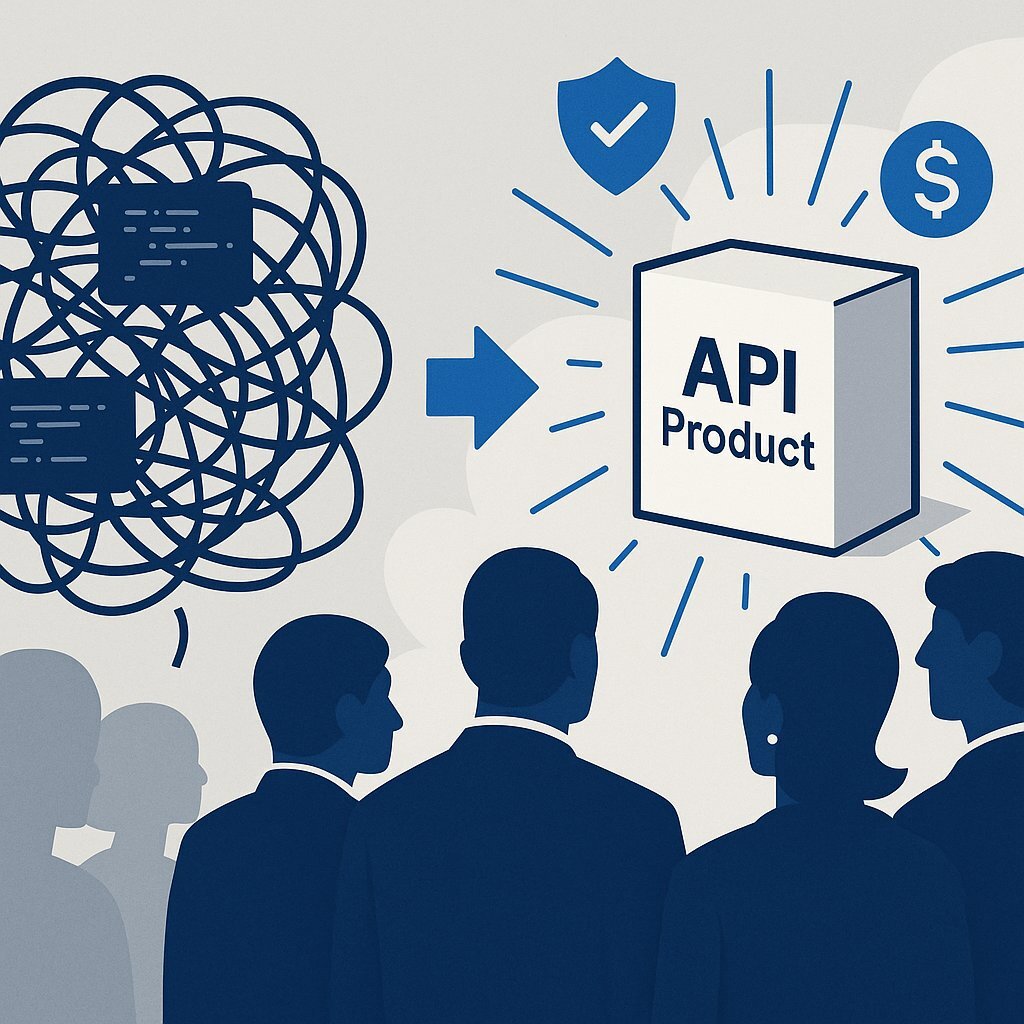
The scale of this transformation is staggering, and the market data underscores its urgency for technology leaders. The global API management market, which encompasses the tools and services required to govern this ecosystem, was valued at USD 5.42 billion in 2024. It is projected to surge to USD 32.77 billion by 2032, expanding at a compound annual growth rate (CAGR) of 25.0%. Other analyses project an even more aggressive trajectory, with the market potentially reaching USD 58.7 billion by 2034. This explosive growth is not merely about selling more software; it reflects a fundamental re-architecting of how businesses operate and compete.
However, even these impressive figures only capture the market for the "picks and shovels" of the API gold rush. The true economic impact lies in the value of the "gold" itself—the new services, platform business models, and digital ecosystems that APIs enable. Projections estimate that by 2027, APIs will contribute a colossal $14.2 trillion to the global economy. This broader valuation accounts for the explosive growth in sectors that are entirely dependent on APIs, such as AI, which relies on APIs for data exchange and integration, and Web3, which owes its very existence to them. The variance in market forecasts is not a contradiction but a clear signal of a rapidly expanding definition of value, shifting from the tools themselves to the economic activity they unlock.
For Chief Technology Officers and product leaders, this data presents a clear mandate. The conversation around APIs must evolve beyond technical discussions of integration and efficiency. To capture a share of this multi-trillion-dollar opportunity, leaders must orchestrate a fundamental shift in perspective across their organizations: they must stop treating APIs as disposable, project-specific code and start designing, building, and managing them as strategic, revenue-generating products. This report provides a comprehensive blueprint for making that transition.
The Strategic Imperative: Adopting the API-as-a-Product Mindset
The single most critical step toward thriving in the API economy is a cultural and operational paradigm shift: treating every API as a product. An "API product" is not necessarily something sold directly to external customers, like the offerings from Twilio or Stripe. In its most powerful application, an API product is any business-focused digital capability, packaged and exposed as a well-managed API, whether for internal teams, strategic partners, or the public market. This requires moving from an "inside-out" approach, where technical functions are simply exposed, to an "outside-in" strategy that begins with the needs of the consumer—the developer.
This transition addresses a critical and costly disconnect that exists in many organizations. According to a 2023 survey, a staggering 46% of developers report that their senior leadership lacks a strong understanding of the strategic value of APIs. This C-suite knowledge gap is the primary inhibitor to realizing the documented benefits of a robust API program, which include increased agility (reported by 67% of organizations), enhanced team productivity (65%), and direct revenue growth (50%).
When leadership views APIs as a project-level IT expense rather than a product investment, a predictable and damaging pattern emerges. Without a centralized strategy, individual teams build bespoke APIs for their immediate needs, leading to a chaotic and unmanaged proliferation of redundant, inconsistent, and poorly documented interfaces—a phenomenon known as "API sprawl". This sprawl becomes a significant source of technical debt, operational inefficiency, and, most alarmingly, security vulnerabilities, as each unmanaged API represents a potential attack vector.
Adopting an API-as-a-Product mindset is therefore a direct risk mitigation strategy against this organizational drag. It reframes APIs from a source of debt into a portfolio of valuable, reusable assets. This transformation is driven by two key elements: the establishment of the API Product Manager role and the adoption of a structured product lifecycle framework.
The Rise of the API Product Manager
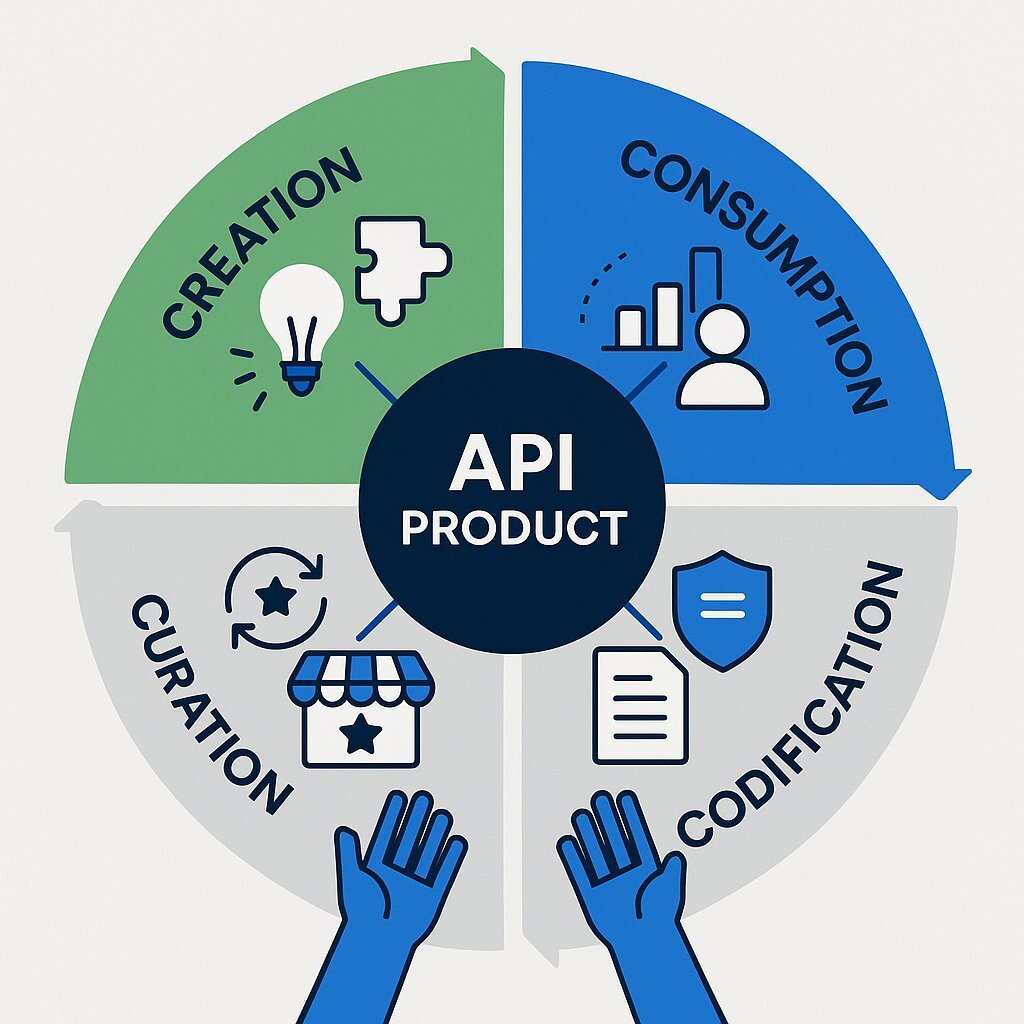
The API Product Manager is the linchpin of a successful API strategy. This specialized role serves as the crucial bridge between three domains:
- Users (Developers): They champion the developer experience (DX), understanding that for an API, the developer is the customer. This requires a deep empathy for developer workflows and a focus on creating intuitive, well-documented, and easy-to-use products.
- Commercial Teams: They align API capabilities with broader business objectives, defining monetization strategies, pricing, and market positioning to ensure that each API product contributes to commercial goals.
- Technology Teams: They possess the technical acumen to translate developer needs into concrete product requirements, working closely with engineering to guide the development and implementation process.
In essence, the API Product Manager runs the API as a business, owning its vision, roadmap, lifecycle, and ultimate success in the market.
The 4 C's: A Framework for API Product Management
A successful API-as-a-Product strategy can be structured around a continuous lifecycle known as the "4 C's":
- Creation: The process begins by identifying a business capability that can solve a customer's problem. This is an outside-in process, driven by user needs, not by what is technically convenient to expose.
- Consumption: Once created, the API product's success is measured by its consumption. This requires a product owner to analyze usage metrics, profile how the API is being used, and gather feedback to drive improvements.
- Codification: This involves establishing the "rules of the road"—clear governance, security standards, and usage policies. These rules ensure that the API is used as intended and that the ecosystem remains secure and stable.
- Curation: An API product is never "done." Curation is the ongoing process of evolving the API based on market feedback, managing its presence in a developer portal or marketplace, and making strategic decisions about versioning and sunsetting.
By embracing this product-centric approach, organizations transform their APIs from a source of hidden risk into a well-managed portfolio of strategic assets, ready to drive innovation and create sustainable value.
Blueprint for Excellence: Designing APIs for Consumption and Scale
In the API economy, adoption is the ultimate measure of success. An API, no matter how powerful its underlying technology, is worthless if developers find it difficult to understand, cumbersome to integrate, or unreliable in practice. Excellence in this domain is not accidental; it is the result of a deliberate, design-first philosophy that prioritizes the developer experience (DX) from the very beginning. This approach treats the API as a business asset and begins with three foundational strategic questions: What problem does this API solve for people? Who, specifically, are the developers who will use it? And how will it differentiate itself in a competitive landscape?
At the heart of this design process lies a critical architectural decision that will shape the API's capabilities, performance, and long-term evolution: the choice between REST and GraphQL.
Architectural Crossroads: Choosing Between REST and GraphQL
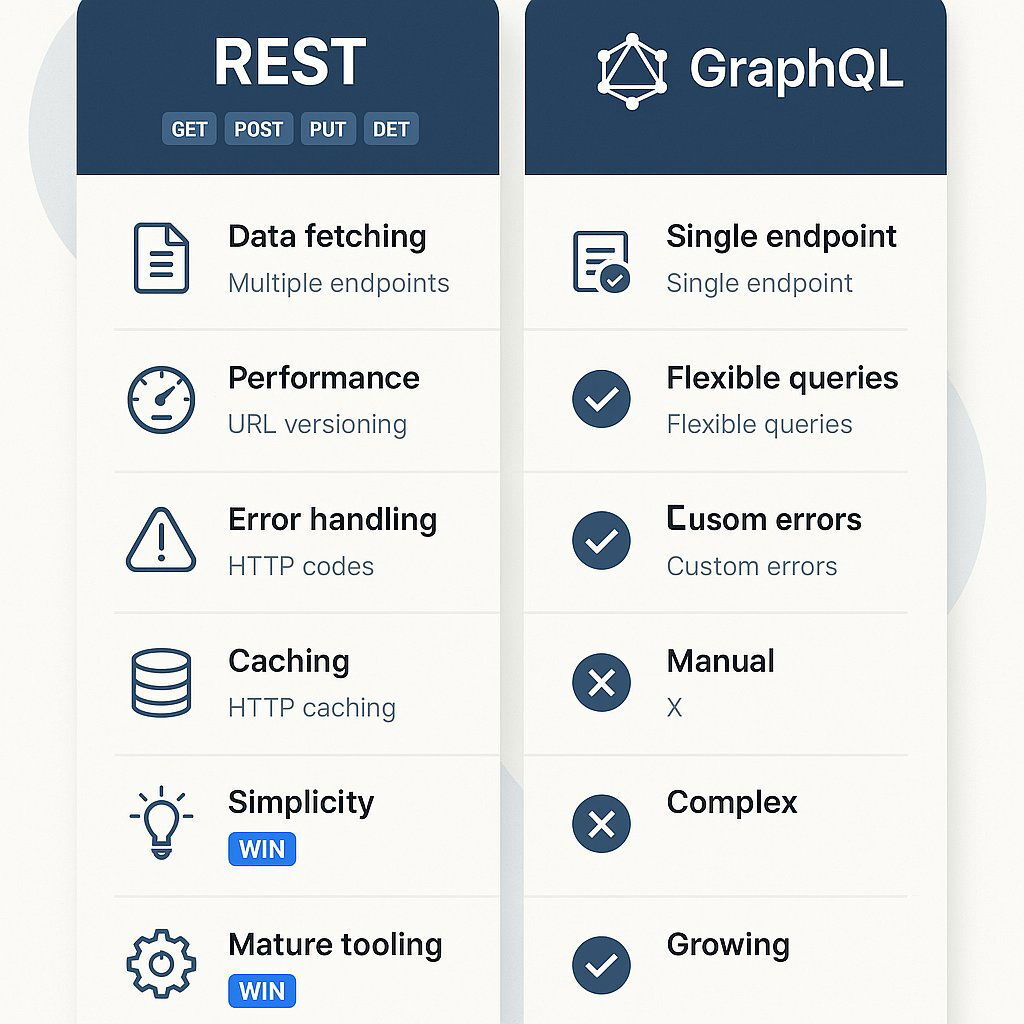
Representational State Transfer (REST) has been the dominant architectural style for APIs for over two decades, with a recent survey indicating that it is used by 86% of developers. Its principles are built upon the standard, stateless operations of the HTTP protocol (GET, POST, PUT, DELETE), making it familiar, language-agnostic, and relatively straightforward to implement. However, its rigid, resource-based structure often leads to two significant inefficiencies:
- Over-fetching: A client receives a fixed data structure containing more information than it needs, wasting bandwidth and increasing processing load.
- Under-fetching: A client needs to make multiple API calls to different endpoints to gather all the necessary information, increasing network latency and application complexity.
GraphQL, introduced by Facebook in 2015, was designed specifically to solve these problems. It is a query language for APIs that operates over a single endpoint. This allows the client application to specify exactly which data fields it requires in a single request, eliminating both over-fetching and under-fetching. While GraphQL offers superior data-fetching flexibility, built-in support for real-time updates via subscriptions, and a strongly typed schema that simplifies versioning, it also introduces greater complexity on the server side and presents different caching challenges compared to REST.
The choice between these two architectures is not merely technical; it is a strategic decision that must align with the organization's business model. A company providing standardized, well-defined data sets to a stable partner ecosystem may find REST's maturity and simplicity more cost-effective. In contrast, a business aiming to become a platform that supports a diverse and rapidly evolving range of applications (especially mobile, where network efficiency is paramount) will likely gain a significant competitive advantage from GraphQL's flexibility. The API architecture is, in effect, a proxy for the product strategy.
| Criterion | REST (Representational State Transfer) | GraphQL (Graph Query Language) |
|---|---|---|
| Data Fetching | Fixed data structure per endpoint; prone to over-fetching or under-fetching. | Client specifies required data in a single query to one endpoint, eliminating over/under-fetching. |
| Performance | Can require multiple round-trips to the server, increasing latency for complex data needs. | Optimized for single round-trip data retrieval, reducing network overhead, which is ideal for mobile apps. |
| Versioning | Typically versioned in the URL (e.g., /v2/users); changes can be breaking, requiring new endpoints. | Evolves by adding new fields to the schema without breaking existing clients; reduces the need for explicit versioning. |
| Error Handling | Uses standard HTTP status codes (e.g., 404 Not Found, 500 Server Error) to indicate request status. | Typically returns a 200 OK status code even for errors, with detailed error messages included in the response body. |
| Caching | Leverages standard HTTP caching mechanisms effectively due to distinct URLs for each resource. | More complex to cache at the HTTP level due to a single endpoint; requires more sophisticated client-side caching strategies. |
| Learning Curve | Relatively easy for developers familiar with HTTP to learn and implement. | Steeper learning curve; requires understanding of schemas, types, queries, and mutations. |
| Ecosystem | Mature and vast ecosystem with extensive tooling and community support. | Rapidly growing community and ecosystem, but less mature than REST's. |
Core Principles of Enterprise API Design
Regardless of the chosen architecture, a set of core design principles is essential for creating APIs that are scalable, maintainable, and developer-friendly. For enterprise-grade REST APIs, these best practices include:
- Resource-Oriented Naming: Use nouns (preferably plural) to represent resources (e.g.,
GET /api/customers/{id}/orders), not verbs. The HTTP method already specifies the action. - Proper Use of HTTP Methods: Adhere to the semantics of HTTP verbs:
GETfor retrieval,POSTfor creation,PUTorPATCHfor updates, andDELETEfor removal. - Consistent URI Structure: Use a clear, predictable, and hierarchical URI structure. Keep URIs simple and avoid deep nesting (e.g., more than
collection/item/collection). - Graceful Error Handling: Provide clear, structured error messages in the response body and use standard HTTP status codes to indicate the nature of the error (e.g.,
400 Bad Request,401 Unauthorized,404 Not Found). - Support for Filtering, Sorting, and Pagination: For collections of resources, allow clients to filter, sort, and paginate results to manage large datasets efficiently.
Measuring Success: The Primacy of Developer Experience (DX)
Ultimately, the quality of an API's design is measured by its ability to provide a seamless developer experience. DX is about making a developer's work easy, efficient, and satisfying. While qualitative feedback is useful, a quantitative, data-driven approach provides a more objective measure of an API product's performance. Key DX metrics to track include:
- Time to First Win (TTFW): This is the most critical metric. It measures the time it takes for a developer to go from signing up to achieving a meaningful business outcome with the API, not just making a simple "hello world" call. A long TTFW is a clear indicator of friction in onboarding or documentation.
- Adoption and Churn Rates: These metrics track how many developers are starting to use the API versus how many are abandoning it, providing a high-level view of the product's market fit and perceived value.
- Error Rates and Resolution Time: High error rates combined with a long time to resolve those errors often point directly to flaws in API design, confusing documentation, or inadequate support resources.
By focusing on these design principles and metrics, organizations can create API products that not only function correctly but are actively sought out and adopted by the developer community, driving the growth of their digital ecosystem.
From Blueprint to Reality: The Baytech Consulting API Factory
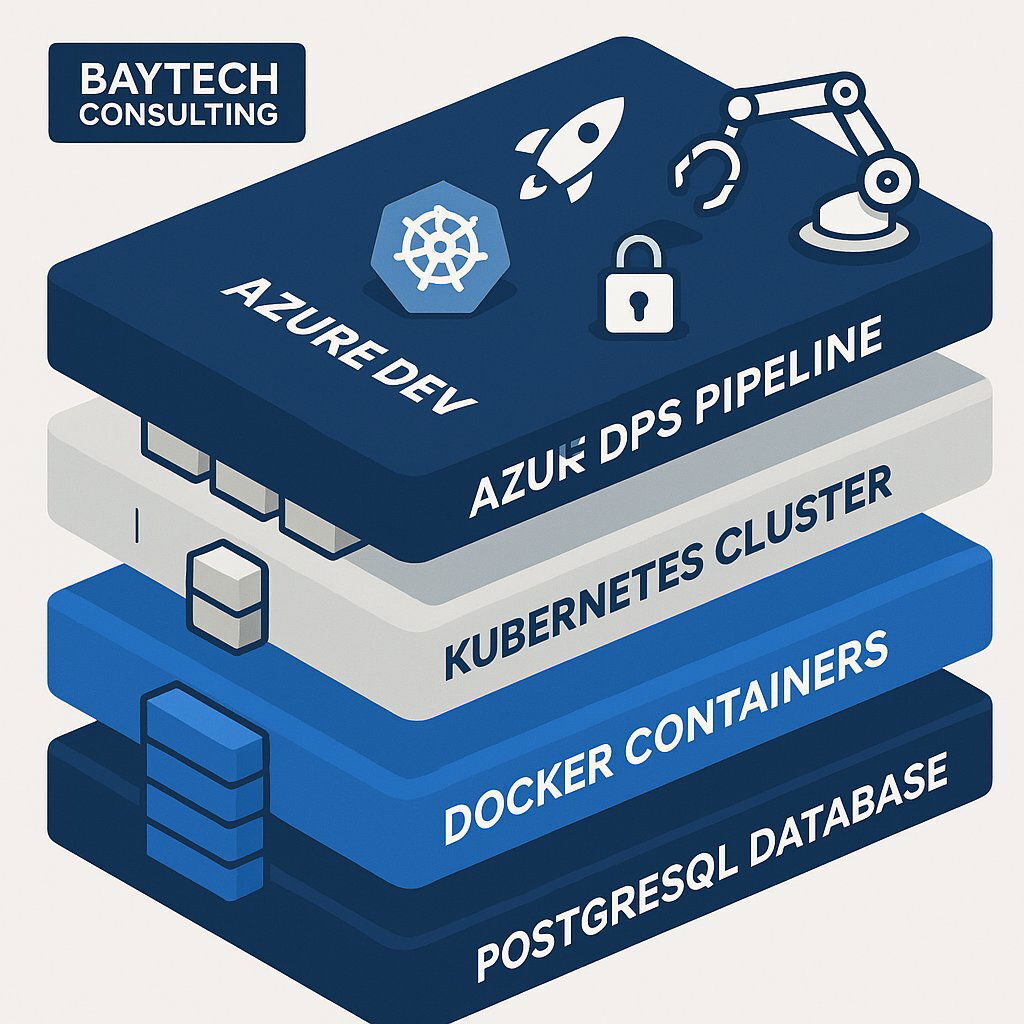
Translating a strategic API design into a scalable, secure, and reliable product requires a modern engineering platform—an "API Factory" capable of rapid, agile deployment without sacrificing enterprise-grade governance. At Baytech Consulting, we have engineered such a factory by integrating a best-of-breed technology stack designed to create a virtuous cycle of speed and control. This stack provides the foundation for building and managing a portfolio of API products that can evolve at the pace of business.
The core challenge in modern enterprise software development is balancing the need for rapid iteration with the non-negotiable requirements of security, reliability, and compliance. Our approach directly addresses this tension by using automation to embed governance into the development lifecycle, empowering teams to move quickly because the guardrails are built-in. This is the principle of "governed agility."
The Four Pillars of the Baytech API Factory
Our recommended stack is not merely a collection of popular tools; it is an integrated system where each component plays a critical role in the API product lifecycle.
- Containerization with Docker: The foundation of our factory is containerization. We package each API and its dependencies into a standardized, lightweight, and portable Docker container. This encapsulates the application, ensuring it runs consistently across all environments—from a developer's laptop to production servers. This practice is the essential first step toward a modern, microservices-based architecture, allowing for independent development, deployment, and scaling of individual API products.
- Orchestration with Kubernetes: To manage these containers at scale, we leverage Kubernetes, the industry's de facto standard for container orchestration. Kubernetes automates the deployment, scaling, and operational management of containerized APIs. It provides immense benefits for reliability and scalability, such as automatically restarting failed containers (self-healing), scaling the number of API instances up or down based on traffic load, and optimizing the use of underlying infrastructure. The Kubernetes API itself serves as the powerful control plane for programmatically managing the entire application landscape.
- Data Persistence with PostgreSQL: For the critical task of data storage, we rely on PostgreSQL. As a powerful, open-source object-relational database system, PostgreSQL has a decades-long reputation for reliability, data integrity, and high performance, making it an ideal choice for the backend of enterprise-grade APIs. Its robust support for both traditional relational data (SQL) and non-relational data (JSON) provides the flexibility needed for modern application development. Furthermore, the PostgreSQL ecosystem includes tools like PostgREST, which can automatically generate a secure RESTful API directly from the database schema, dramatically accelerating the development of data-centric API products.
- Lifecycle Automation with Azure DevOps (APIOps): Azure DevOps is the central nervous system of our API Factory, automating the entire lifecycle from code to deployment in a methodology known as APIOps.
- Azure Repos: We use Git-based Azure Repos as the single source of truth for all API-related artifacts. This includes not only the application source code but also the API definitions (e.g., OpenAPI specifications), infrastructure-as-code configurations, and governance policies. This "governance-as-code" approach ensures that every change is versioned, auditable, and subject to peer review through pull requests.
- Azure Pipelines: This is the engine of automation. We construct CI/CD (Continuous Integration/Continuous Delivery) pipelines that trigger automatically when a developer commits a change to Azure Repos. These pipelines automate the entire workflow: building the Docker container, running a suite of automated tests (unit, integration, and security scans), linting the API specification against organizational standards, and finally, deploying the containerized API to the Kubernetes cluster. This process can be configured for multiple environments, allowing for safe, progressive delivery from development to staging and finally to production.
This integrated system empowers development teams with the autonomy to innovate and deploy rapidly, while the central platform team maintains control by defining the automated checks and balances within the Azure Pipelines. It transforms the API lifecycle from a series of manual, error-prone handoffs into a streamlined, secure, and highly efficient factory for producing high-quality API products.
Governance and Management: Operating Your API Portfolio for Long-Term Value
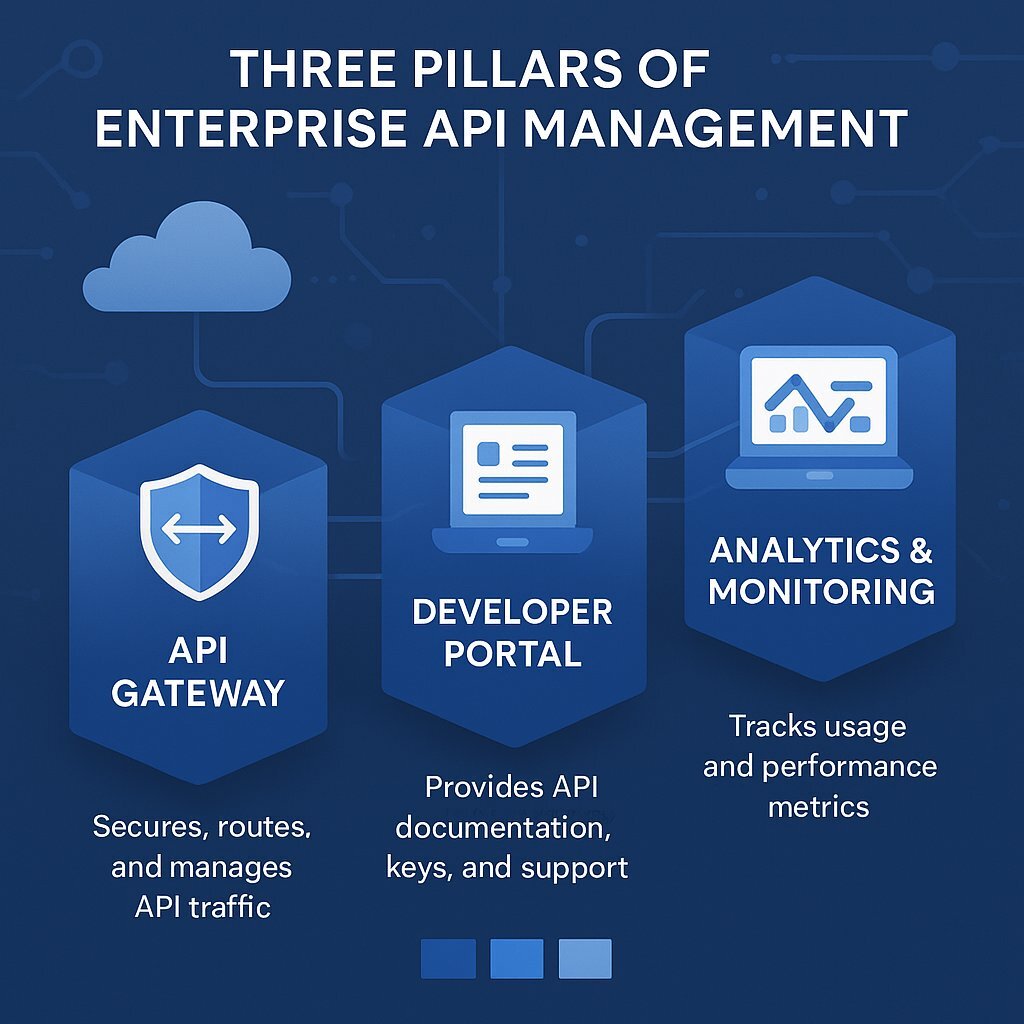
Deploying an API is not the end of its journey; it is the beginning of its life as a managed product. Without a robust governance and management framework, even the best-designed APIs can become security risks, performance bottlenecks, or undiscoverable "dark" assets within the organization. Effective API management is not about imposing restrictive controls; it is about creating a trusted, reliable, and efficient marketplace for your digital capabilities, which is the essential foundation for fostering a vibrant internal and external developer ecosystem.
A comprehensive API management strategy addresses the full product lifecycle, from initial design and publication through ongoing monitoring, maintenance, versioning, and eventual, planned retirement. This requires a dedicated platform that provides three core components.
Core Components of API Management
- API Gateway: The API Gateway acts as the single, secure entry point for all API traffic. It is a critical control plane that decouples API consumers from backend services, allowing backend architecture to evolve without breaking client integrations. Its primary responsibilities include:
- Security Enforcement: Verifying credentials such as API keys or OAuth 2.0 tokens to authenticate requests and enforcing authorization policies to ensure consumers only access the data they are permitted to.
- Traffic Management: Applying rate limiting and usage quotas to protect backend services from being overwhelmed by traffic, prevent abuse, and ensure fair usage among consumers.
- Request Routing: Intelligently routing incoming requests to the appropriate backend microservice or legacy system.
- Caching: Caching responses to frequently requested, non-volatile data to improve performance and reduce load on backend systems.
- Developer Portal: The Developer Portal is the public-facing "storefront" or "marketplace" for your API products. A world-class developer portal is the cornerstone of a great developer experience and is essential for driving API adoption. It must provide a self-service experience that includes:
- Comprehensive Documentation: Clear, detailed, and easy-to-navigate documentation that explains what each API does, its endpoints, data models, and authentication requirements.
- Interactive Console: An interactive environment where developers can test API calls directly from the browser to understand request and response formats.
- Self-Service Onboarding: A streamlined process for developers to register, create applications, and obtain API keys or credentials without manual intervention.
- Usage Analytics: Dashboards that allow developers to monitor their own API consumption, track performance, and view error logs.
- Analytics and Monitoring: You cannot manage what you cannot measure. A robust analytics engine is vital for API product managers to understand how their products are being used and to make data-driven decisions. This involves tracking key metrics such as:
- Usage Patterns: Which APIs and endpoints are most popular? Who are the top consumers?
- Performance: Monitoring latency and uptime to ensure service level agreements (SLAs) are being met.
- Errors: Tracking error rates and types to identify bugs or areas where the developer experience can be improved.
Security: A Non-Negotiable Foundation
Given that APIs expose direct pathways to business logic and data, security must be a foundational element of any management strategy, not an afterthought. APIs are a primary target for attackers, and a single vulnerability can lead to a catastrophic data breach. A multi-layered security approach is essential:
- Strong Authentication and Authorization: Implement industry standards like OAuth 2.0 and OpenID Connect to securely manage identity and access control.
- Rate Limiting and Throttling: As enforced by the API Gateway, these are critical defenses against Denial-of-Service (DoS) attacks and other forms of abuse.
- Comprehensive Audit Logging: Meticulously log every API interaction. These logs are not just for debugging; they are a critical security tool for detecting anomalous behavior, investigating potential breaches, and ensuring compliance.
- Data Encryption: All data must be encrypted in transit using TLS and sensitive data should be encrypted at rest in the backend databases.
By investing in a comprehensive API management platform, an organization provides the enabling infrastructure that makes it easier for developers to build securely, discover and reuse existing assets, and innovate with confidence. This transforms governance from a bottleneck into a powerful accelerator for ecosystem growth.
Unlocking Revenue: Monetizing Your API Products
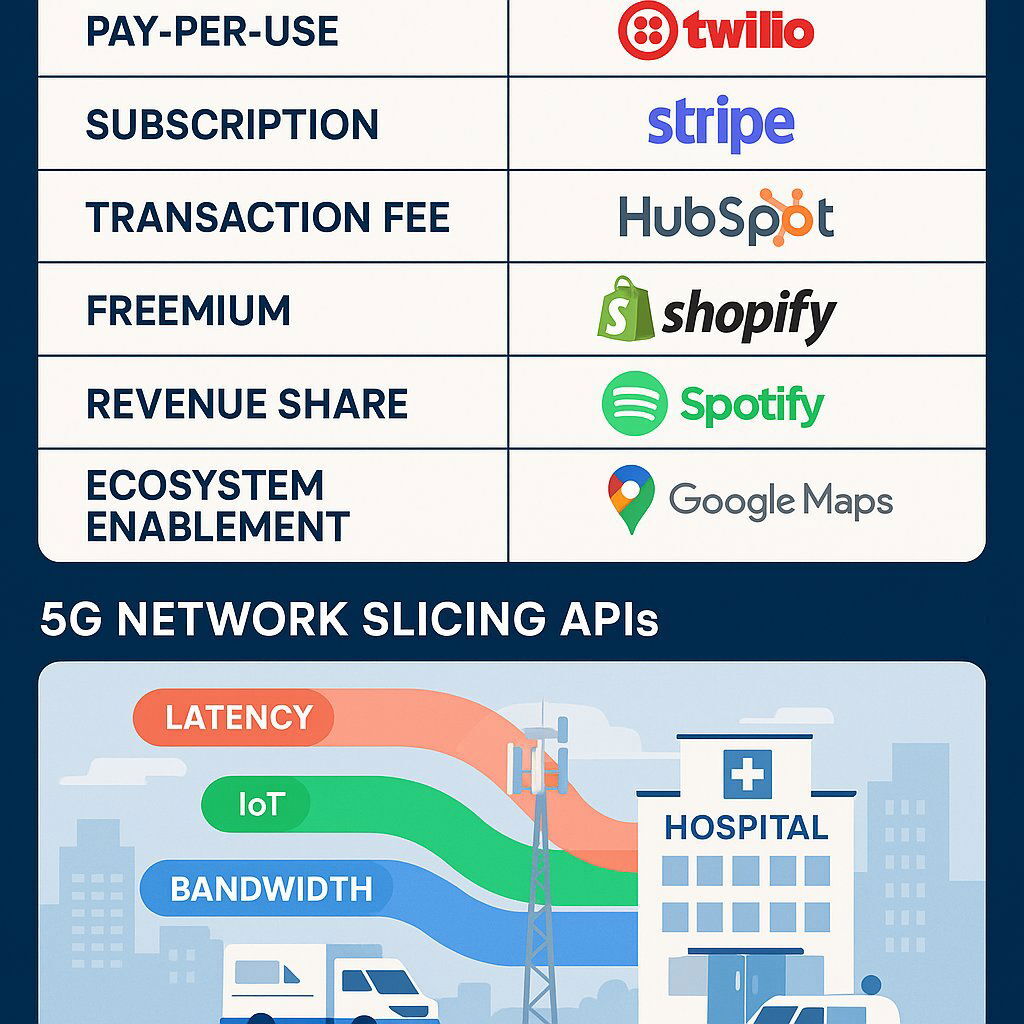
Once an API is treated as a product, the natural next step is to consider its commercial value. API monetization is the process of generating revenue from your API portfolio, but it is not a one-size-fits-all endeavor. The right strategy depends on the API's function, its target audience, and its role within the broader business model. Monetization strategies can be broadly categorized into two types: direct, where you charge for access to the API itself, and indirect, where the API drives revenue for other products or services.
Direct Monetization Models
In these models, the API is the product being sold. This approach is most common for companies whose core offering is a digital service or data set.
- Pay-per-Use (or Pay-per-Call): This is the most straightforward model, where consumers are charged for each API call they make. It directly ties cost to value and scales with usage. This model is used by Twilio for its communication APIs (charging per SMS or voice minute) and by the Google Maps Platform for requests to its mapping services.
- Transaction Fee: A variation of the pay-per-use model, where the provider takes a small percentage or a flat fee for each transaction processed via the API. This is the cornerstone of Stripe's business model, which charges a percentage of every payment it processes for its customers.
- Subscription (Tiered): Consumers pay a recurring fee (monthly or annually) for a specific level of access. Tiers are often structured around usage quotas (e.g., number of API calls per month), access to advanced features, or higher service levels (SLAs). HubSpot uses a tiered subscription model for its marketing and sales APIs, with pricing based on the number of contacts in a customer's database.
- Freemium: This model offers a free, often limited, tier of service to encourage widespread adoption and allow developers to experiment without commitment. The goal is to convert free users to paid tiers once they exceed usage limits or require premium features. This strategy has been highly effective for companies like Google Maps, which provides a generous free quota of API calls to attract a large developer base.
Indirect Monetization Models
In these models, the API is often free to use but creates value by enhancing a core product, building a partner ecosystem, or increasing customer loyalty.
- Ecosystem Enablement (or Revenue Share): The API serves as the foundation for a partner ecosystem or marketplace. The provider may not charge for the API itself but takes a share of the revenue from applications or services sold through the platform. This is the model perfected by Shopify, whose APIs allow third-party developers to build apps for the Shopify App Store. Shopify then shares in the revenue generated by those app sales, creating a powerful network effect.
- Product Adoption / Value-Add: The API is a feature of a larger product, and its primary purpose is to increase the adoption, utility, and "stickiness" of that core product. Spotify's Web API is a classic example. It allows developers to integrate Spotify's music playback and playlist functionality into their own applications, which drives user engagement and keeps them subscribed to the core Spotify streaming service.
The following table provides a strategic overview to help leaders select the appropriate model for their API products.
| Monetization Model | Description | Best For (Use Case) | Real-World Example (Company) |
|---|---|---|---|
| Pay-per-Use | Charge for each individual API call or unit of data. | Services where value is delivered discretely with each call (e.g., sending a text, geocoding an address). | Twilio, Google Maps Platform |
| Subscription (Tiered) | Recurring fee for a defined level of access and features. | Providing continuous access to data or services where usage is predictable (e.g., market data, CRM access). | HubSpot |
| Transaction Fee | A percentage or flat fee charged on the value of a transaction. | Financial services, payment processing, e-commerce, and booking platforms. | Stripe |
| Freemium | A free tier to encourage adoption, with paid tiers for higher usage or premium features. | Public APIs aiming to build a large developer community and establish a de facto standard. | Google Maps Platform |
| Revenue Share | API provider takes a percentage of revenue from partner applications built on the API. | Creating a platform or marketplace where third parties sell goods or services. | Shopify (App Store) |
| Ecosystem Enablement | Free API that enhances the value of a core product, driving its adoption and retention. | Companies with a core product that benefits from integrations and a strong network effect. | Spotify |
Choosing the right monetization model requires a deep understanding of the value your API provides and the business goals you aim to achieve. It is a critical component of treating your API as a true product.
The Future in Focus: APIs as the Enabler of Next-Generation Business Models
A mature, product-oriented API strategy does more than optimize current operations; it is a foundational investment that positions an organization to compete and innovate in the next wave of technological disruption. The ability to abstract complex infrastructure and expose its capabilities as simple, consumable digital products is becoming the primary driver of competitive advantage. This is not a distant theoretical concept; it is happening now in industries being reshaped by technologies like 5G, AI, and embedded finance.
Case Study: Monetizing 5G Through Network Slicing APIs
The rollout of 5G is a perfect illustration of this shift. One of 5G's most revolutionary features is "network slicing," which allows a single physical network to be virtually partitioned into multiple, isolated end-to-end networks. Each slice can be tailored with specific, guaranteed characteristics—such as ultra-reliable low latency for remote surgery, massive connectivity for IoT sensors, or enhanced mobile broadband for live 4K video streaming.
For a telecommunications operator, the physical 5G infrastructure is a massive capital investment. The critical question is how to monetize these differentiated network capabilities. The answer is unequivocally through APIs. An enterprise—be it a hospital, a logistics company, or a media broadcaster—cannot purchase a physical "slice" of the network. Instead, they will consume it as a service, programmatically provisioned and managed through a set of network APIs.
These APIs become the product interface to the network's most valuable features. An operator can offer a "Low-Latency Slice API" or a "High-Bandwidth Slice API," applying direct monetization models like subscriptions or usage-based fees. This transforms a complex piece of infrastructure into a portfolio of distinct, high-value digital products. The API is not just an integration tool; it is the commercial product itself.
The Symbiotic Relationship with AI and Web3
This pattern extends to the most transformative technologies on the horizon. Artificial Intelligence, for all its complexity, is functionally dependent on APIs. They are the "eyes, ears, and hands of AI," serving as the essential conduits for the vast amounts of data required for training models and for integrating AI-driven insights back into applications and business processes. As organizations increasingly adopt AI, a robust, secure, and well-managed API strategy becomes a prerequisite for success. Without a solid API foundation, attempts to implement AI solutions at scale will struggle. Leaders interested in how software maintenance supports this lifecycle may also appreciate our executive guide to post-launch software evolution.
Similarly, the decentralized architectures of Web3 and blockchain technologies are built upon a foundation of APIs that facilitate communication and transactions between nodes and applications.
The strategic implication for technology leaders is profound. The future of competitive advantage lies not in simply owning proprietary assets—be it a telecom network, a banking license, or a logistics fleet—but in the ability to programmatically expose the unique capabilities of those assets as easily consumable digital products. The historical advantage of physical scale is being superseded by the advantage of digital agility and ecosystem integration. An organization's API strategy is, therefore, its de facto business model for the future. It dictates how the company will package, sell, and deliver its core competencies as digital services in an increasingly interconnected and programmable world.
Conclusion and Call to Action
The transition from viewing APIs as technical connectors to treating them as strategic products is no longer an option for forward-thinking enterprises; it is a fundamental necessity for survival and growth in the digital age. The API economy represents a multi-trillion-dollar opportunity, but accessing it requires a deliberate and holistic strategy that aligns technology, product management, and business objectives.
The journey begins with a crucial mindset shift at the leadership level, recognizing that a well-managed API portfolio is a powerful engine for agility, innovation, and revenue. This strategic vision must be empowered by the dedicated ownership of an API Product Manager, who can guide each API through a rigorous product lifecycle, ensuring it meets the needs of its developer-customers.
Success in this endeavor hinges on a modern, automated technology platform—an "API Factory" like the one engineered by Baytech Consulting. By integrating the power of Azure DevOps for CI/CD automation, Docker for containerization, Kubernetes for scalable orchestration, and PostgreSQL for reliable data persistence, organizations can achieve the governed agility required to deliver high-quality API products at the speed the market demands.
This foundation of excellent design, robust management, and a clear monetization strategy does more than optimize current business; it prepares the enterprise for the future. It is the prerequisite for capitalizing on transformative trends like 5G, AI, and embedded finance, where the ability to productize and expose core business capabilities via APIs will be the primary determinant of market leadership.
The path to API maturity is a significant undertaking, requiring expertise in strategy, architecture, and execution. Baytech Consulting is the expert partner ready to guide your organization through every stage of this transformation. We help technology leaders assess their current API maturity, develop a strategic roadmap aligned with business goals, and implement the technical and organizational frameworks necessary to thrive in the API economy. Contact us to begin building your API-as-a-Product future today.
Further Reading
For leaders looking to delve deeper into the strategic dimensions of the API economy, the following resources provide expert perspectives on key topics:
- Gartner® Report: How to Adapt Your API Strategy to Succeed in the AI Era. This report offers an authoritative, forward-looking analysis of how the rise of AI is reshaping API strategy. It is an essential read for leaders planning for the next wave of technological integration, focusing on the new opportunities and risks presented by AI agents and LLMs as API consumers.
- Torry Harris: API Strategy – critical for successful Digital Transformations. This article provides a high-level, business-centric view of APIs as products and their central role in creating platform business models. It is highly relevant for CTOs and product leaders focused on leveraging APIs for broad digital transformation initiatives, similar to approaches detailed in executive strategies for scaling SaaS.
- Solutions Review: API Security Best Practices That CTOs Can Action Today. Security remains a top concern for any technology leader. This article directly addresses a CTO audience, framing API security not just as a technical checklist but as a strategic imperative involving risk management, the financial impact of breaches, and the importance of fostering a security-conscious culture. For a deeper dive into how configuration complexity can introduce risk and undermine security, see our guide on the Configuration Complexity Clock.
- For readers interested in how open-source dependency risk impacts API and supply chain security, explore our open-source supply chain phishing attack analysis for practical prevention strategies.
About Baytech
At Baytech Consulting, we specialize in guiding businesses through this process, helping you build scalable, efficient, and high-performing software that evolves with your needs. Our MVP first approach helps our clients minimize upfront costs and maximize ROI. Ready to take the next step in your software development journey? Contact us today to learn how we can help you achieve your goals with a phased development approach.
About the Author

Bryan Reynolds is an accomplished technology executive with more than 25 years of experience leading innovation in the software industry. As the CEO and founder of Baytech Consulting, he has built a reputation for delivering custom software solutions that help businesses streamline operations, enhance customer experiences, and drive growth.
Bryan’s expertise spans custom software development, cloud infrastructure, artificial intelligence, and strategic business consulting, making him a trusted advisor and thought leader across a wide range of industries.


